In the 19th century, hysteria was considered a diagnosable physical illness among women. The symptoms ranged from seizures, mood swings, anxiety, shortness of breath, pain, bizarre movements, hallucinations and inability to speak. The word hysteria, in itself, originates from a Greek word “hystera: – which means uterus.
This symptoms, ‘only seen in women’, was said to be caused by a “wandering uterus” according to the Egyptians in 1900 BC. It was said that the uterus would wander around the body, “in order to ‘look for semen’, affecting different parts. Later, other western ideologies contributed these symptoms to various reasons – all related to women, of course. From abnormalities in the womb to problems with reproduction, the women, their bodies and sexuality were to be blamed.
To make matters worse, the concept which was a medical problem according to most, was demonised in The 13th century. St. Augustine, a saint in the Latin West, stated that “all the sufferings of humankind take place due to sin”. This meant that apart from physical and sexual abuse of women in the name of “hysteria”, like inserting liquids into their uterus, rape or “forced sexual activities”, the women were then exorcised, told to wear various amulets and ostracised from society. Many of them were labelled as witches, and underwent persecution, interrogations, torture, and execution.
According to a blogpost called “Hysteria, Witches, and the Wandering Uterus”, Barbara Ehrenreich and Deirdre English argue that the first accusations of witchcraft in Europe grew out of church-affiliated male doctors’ anxieties about competition from female healers.








